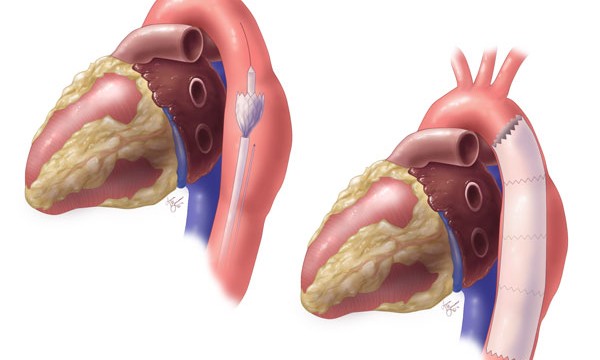EVAR & TEVAR FOR AORTIC DISSECTION & ANEURYSM
AORTIC DISSECTION
Aorta is the largest artery in the body and arising directly from the heart. Aortic dissection occurs when a tear develops in the wall of the aorta. As the tear extends along the wall of the aorta, blood can flow in between the layers of the blood vessel wall (dissection). This can lead to aortic rupture or decreased blood flow to organs. In most cases, the symptoms begin suddenly, and include severe chest pain. The pain may mimics heart attack. The pain is usually described as tearing or stabbing and radiating to the shoulder blades.
There are 2 types of aortic dissection:
- Type A – aortic dissection which involves ascending aorta and arch
- Type B – aortic dissection which involves descending aorta
Aortic dissection is a medical emergency requiring immediate treatment. Treatment may include surgery or endovascular repair depending on the location of the dissection.
AORTIC ANEURYSM
Aortic aneurysm is a bulge or ballooning in its wall. If an aneurysm grows large, it can burst and cause dangerous bleeding or even death.
There are 2 types of aortic aneurysm:
- Thoracic aortic aneurysms – these involves the part of the aorta running through the chest cavity
- Abdominal aortic aneurysms – these involves the part of the aorta passing through the abdomen
CT aortogram is helpful in the diagnosis of this condition. Small aortic aneurysms which are not causing any symptoms are monitored over time until they become large. When an aortic aneurysm is large or associated with symptoms, it should be repaired by surgery or by endovascular approach like EVAR or TEVAR.
EVAR & TEVAR
EVAR (abdominar EndoVascular Aneurysm/Aortic Repair) and TEVAR (Thoracic EndoVascular Aneurysm/Aortic Repair) are newer techniques used to treat pathology of the aorta, like aortic aneurysm and dissection. The procedure involves the placement of an expandable stent graft within the aorta to treat aortic disease without operating directly on the aorta. Incision is made in both side of groin to cannulate femoral arteries.
It is similar to the approach used for coronary angiography and angioplasty. Then stent-graft is introduced through the femoral artery in the groin and with the use of x-ray guidance and specially-designed instruments, the aneurysm can be repaired from inside the aorta by deploying the stent-graft.
The stent graft provides a new channel for the blood to flow through, reducing the pressure on the diseased area of the artery and helping to prevent a rupture. The recovery time for endovascular repair is less than the recovery time for open abdominal or open chest repair.

